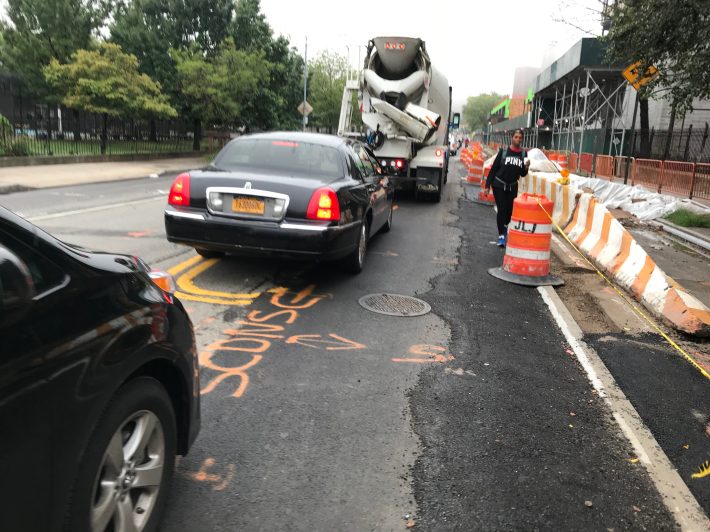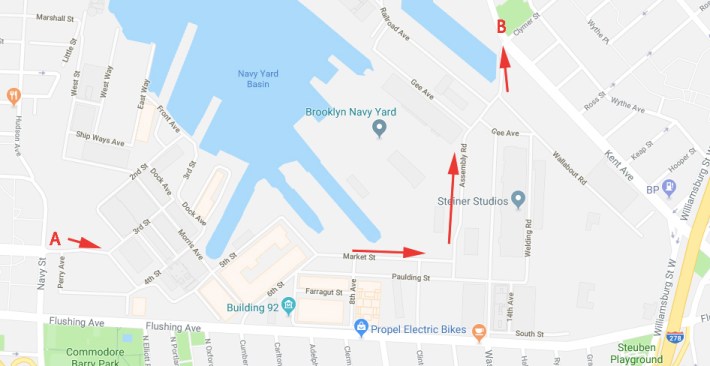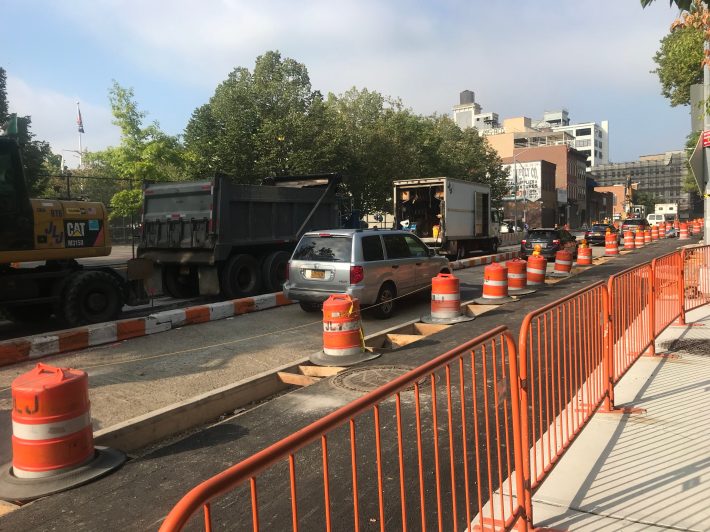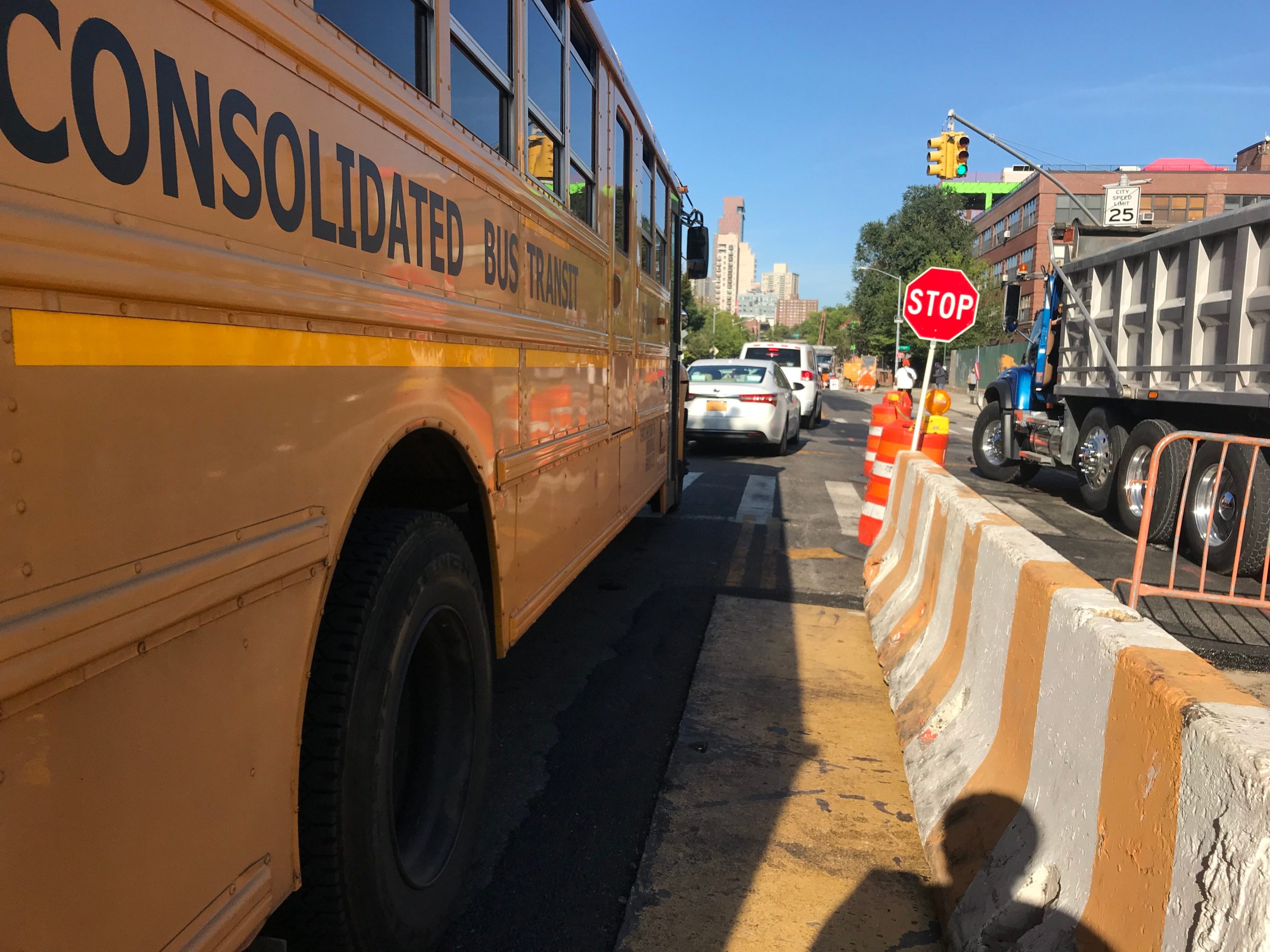Flushing Avenue may one day be a paradise for cyclists, but right now, it is a bone-crunching disaster.
Ongoing, and imperfectly planned, construction on the strip between Kent Avenue and Navy Street — a busy route for hundreds of cyclists per day — has created a dangerous situation that squeezes cyclists into narrowed lanes with motorists and trucks.

No one knows that better than Stephen Brown, a regular cyclist who was badly injured on Flushing Avenue near Navy Street earlier this month. Brown told Streetsblog that he was heading westbound on Flushing when he was forced to leave the bike lane and enter a narrowed lane shared with cars. At that point, construction workers blocked drivers in both directions, so Brown circled around the stopped traffic.
Unfortunately, a motorcyclist had the same idea.
"When I got to Navy Street to make my usual right turn, I knew there would be no cars behind me because they had been stopped," Brown said. "But just as I made the turn, a motorcyclist slammed into me. He had done the exact same thing I had done, except he was racing to make the light to go straight."
Brown said he sprained his wrist and hurt his elbow. "It's been two weeks and I have not been able to get on the bike because I can't fully stretch out my arm yet," he said.
He blamed everyone, including himself.
"There were two causes: A construction project that doesn't accommodate cyclists, and my decision to make the move I made," he said. "The motorcyclist should have been more careful. But that's what happens when [vehicles that are used to going fast] get stuck in traffic. That's when drivers are at their most unpredictable and aggressive. They get frustrated like I did, but I'm just a cyclist, not a 1,000-pound motorcycle or a 3,500-pound car racing to make up lost time."

What's worse, Brown and others have pointed out, there's a simple solution for the dangerous conditions that will persist until April, 2019: The Brooklyn Navy Yard — with its miles of mostly empty, but off-limits, streets — is mere feet away. Opening the private Yard to cyclists could create a nearly direct path from Kent Avenue to the Sands Street protected bike lane used by so many cyclists to safely get to and from the Manhattan Bridge every day.
But a spokesman for the Department of Design and Construction, which is overseeing the repairs that began in June, admitted that no one asked the Navy Yard if it would accommodate cyclists with a safe alternative to the dangerous roadway. (A spokesman for the Navy Yard issued a statement that failed to satisfy: "As an industrial and manufacturing facility, we only allow employees and registered visitors to cycle through the Yard due to safety and security reasons.”)
So what provisions were provided for cyclists during the construction?
"Signs were posted at regular intervals alerting cyclists to proceed with caution during construction," said DDC spokesman Ian Michaels. "The site is inspected regularly to ensure there aren’t any unnecessary obstructions for pedestrians or bicyclists. And we adhere to the traffic plan approved by DOT for the site."

To be clear, the "traffic plan" consists of narrowing segments of the west-bound roadway — which once included a barrier-protected bike lane for the stretch between the Brooklyn-Queens Expressway and Washington Street and then a regular painted lane beyond that. The result is a travel lane that is far too narrow to accommodate anything except a car or truck. The narrowed segments have moved during different phases of the construction. No bike lane has been provided.
Again, DOT might be the culprit here (the agency did not get back to us). The agency could have asked DDC to close Flushing entirely to car traffic — or make the road one-way during construction — but it did not.
"DOT traffic stipulation requires that [the roadway] be maintained throughout the construction," Michaels said.
That decision has led to a "gnarly" situation on Flushing, said Dulcie Canton of Transportation Alternatives, who rides on Flushing in the morning.
"In the evening, I opt for the Williamsburg Bridge so that I can avoid that stretch," she said.
City statistics show that Flushing is indeed less safe, though the data is incomplete.
In June and July of this year, five drivers, cyclists and pedestrians were injured on Flushing Avenue between the BQE and Navy Street. Over the same period last year, only two people were injured. Statistics for August and September are not yet available.
The good news? When DDC is done with the project, it promises to be a tremendous improvement for cyclists — at the expense of drivers.
Not only will there be a raised, two-way bike lane on the north side of Flushing, but buses, which currently cut off cyclists as they veer into and out of traffic to accommodate passengers, will make their westbound pickups directly in the roadway, inconveniencing only motorists. Michaels said his agency did a traffic study and confirmed that buses stopping in the roadway "will not cause traffic to be significantly impacted."
The truth of that study remains to be seen, given that 15 westbound buses on the B57 and B69 routes pass through Flushing Avenue during the morning rush hour, according to MTA schedules. That number, multiplied by the number of new, on-road bus stops, translates to 51 times that a bus will potentially stop in front of cars every morning during the so-called rush hour.






